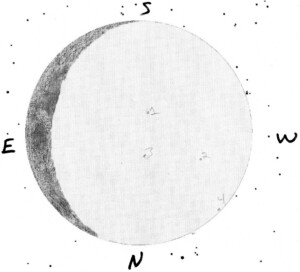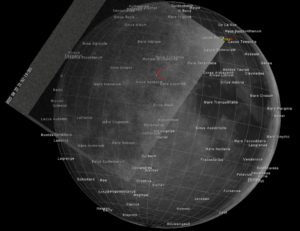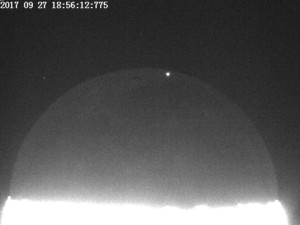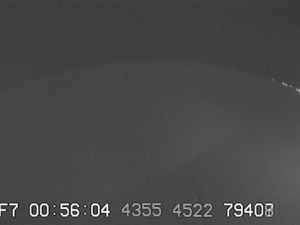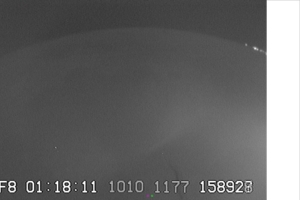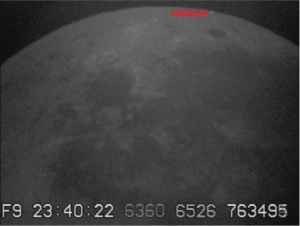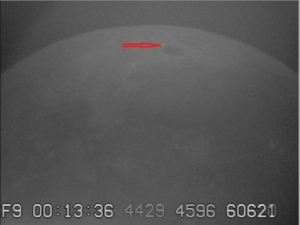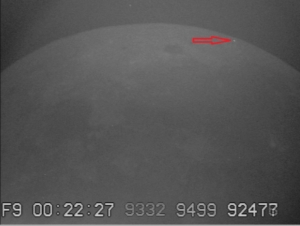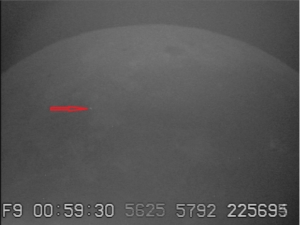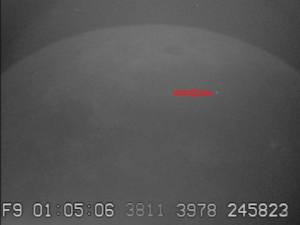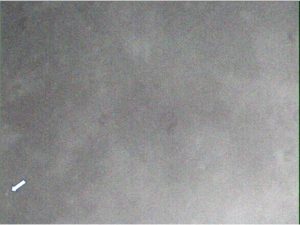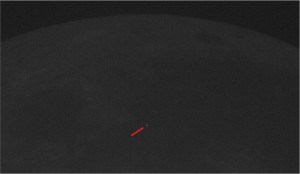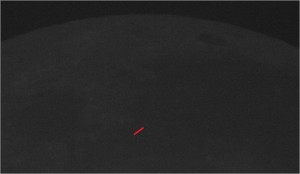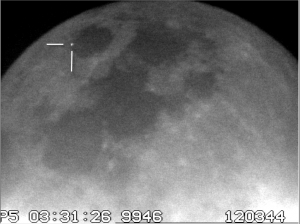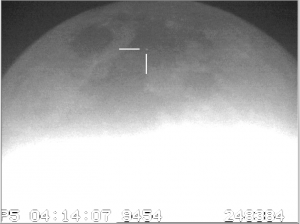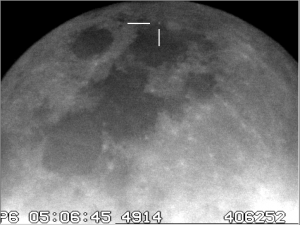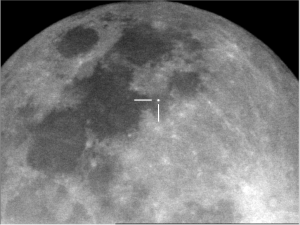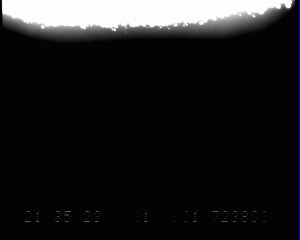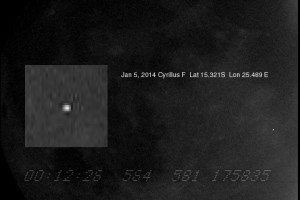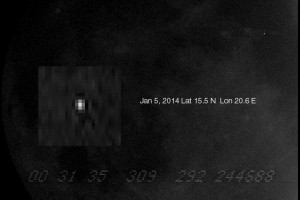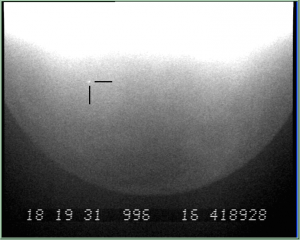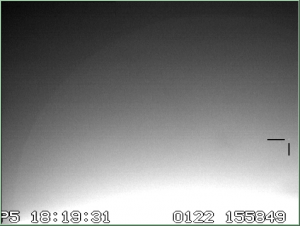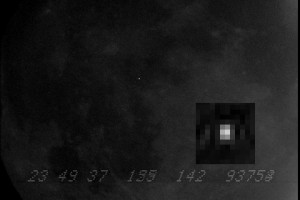Updated April 15, 2024
Quarterly Briefings and Opportunities to Observe Lunar Meteors
IMPORTANT NOTE: We now have another e-mail list or group, lunar-impacts@groups.io and we encourage all those who are interested to sign up.
* * * * * * * * * * * * *
New Reports of Lunar Meteor Impact Candidates
Another Jovian Fireball Recorded
On 15 November 2023, a Japanese amateur astronomer recorded another fireball in Jupiter’s atmosphere. These seem to be happening on a fairly regular basis. All who are able to monitor Jupiter for fireballs are strongly encouraged to do so. Currently, Jupiter is up most of the night, already high enough to observe at dusk, and sets around 3 am local time. One of the goals in the New Year, perhaps by the time the next apparition of Jupiter begins later in 2024, is to set up a Jupiter meteor patrol to monitor Jupiter at all times for more such events. More details on this program are forthcoming.
Lunar Geminid Candidates – 15 December 2023
I received a report about four Geminid meteor candidates, listed below. The observer’s name is Lawrence Garrett, who observed from Vermont. Due to technical and logistical considerations, he was unable to observe with his video setup, so all the observations were visual. Unfortunately he did not provide a date, but based on the lunar phase and UT of the observations, it was almost certainly on 15 December 2023. The Moon was rather low and clouds interfered off-and-on. He watched the Moon from 21:27:00 UT to 22:20:00 UT, before the clouds increased enough to end his session. The observations were made with an 8-inch Celestron telescope, keeping time with a handheld “dual timer” set to radio clock. The details of his report as submitted follows:
Candidate 1 21h:47m28s Strong time recorded—– Gray and wider then suspected cosmic rays—-see detail below
Candidate 2 21h53m12s Strong time recorded—– Gray and wider then suspected cosmic rays—-see detail below
Candidate 3 21h57m00s Time many be 2 seconds in error —-Gray and wider then suspected cosmic rays—see detail below
Candidate 4 22h05m54s Time many be 2 seconds in error—- Limb Candidate brighter than the above with white appearance
The more detailed descriptions follow:
The start of observations at 21h27:00 UT held earthshine very weak, without defined limb at
72x, 6″ f/8 reflector.
But between 21h27:00 and 21h47m, at least 9 very small flashes were seen in the dark limb, one suspected
on the bright lunar disk, and one right on the terminator. I dismiss these as cosmic rays. Indeed, later in the night I seemed to spot a cosmic ray as a line moving right off the dark lunar disk. They seemed far too many to be impacts. They were very pinpoint, white and brief.
Candidates 1-3 were mid disk, larger than pinpoint and gray.
Candidate 4 was one of at least 6 limb suspects, but as only this one seen without side vision,
plotted. These western limb Candidates seemed to have two flashes before lunar limb was visible, and appeared the most like confirmed events are. Of these, three were near the “4” position area, and two or 3 at the “2 O’clock” position.
While I did record periods without flashes, with so many near limit vison events, brighter lunar features near the edge of visibility, I cannot really report these as “no event visible times. As the moon grew brighter, clouds and brightness ended the observing.
This sketch, with the bright lunar crescent presented in dark gray, shows the location of each of the impact candidates relative to the crescent. Confirming video observations are sought.
Lunar Perseid Candidate 13 August 2023
a report from an experience German visual observer, Peter Slansky, who reported a apparent bright impact point flash that he viewed naked-eye on the dark side of the rising crescent Moon during the Perseid meteor shower on 13 August. Based on the location of the flash in his sketch, this was out of the zone that Perseid meteors were impacting and was likely a large sporadic, if it is an actual meteor. The observation was made “from the Tiefenbach glacier near Sölden, Tyrol/Austria, 2940 m altitude. (Observing location was 46.9173° N; 10.9348° E). I have sent the following report to the groups.io list and am providing it below as well.
“Bright flash on the dark side of the Moon on 13 August 2023 at 00:50 UT”
“Shortly after the moon had fully risen, I saw a pinpoint flash on the dark side for a fraction of a second. XXX (his observing partner who apparently wishes to remain anonymous) witnessed my spontaneous exclamation, but he didn’t see it. I ran to my radio clock and noted 02:50:05 CEST as the time of the event (00:50:05 UT; 13.8.2023), with an accuracy of plus minus 3 seconds. I made a sketch of the position immediately after the observation. I have attached the sketch that he made. if the moon was only 2°34’ above the horizon it is likely that few if anyone, in Europe was watching.”

If anyone has been watching the Moon for Lunar Perseids or otherwise and witnessed a flash, please let us know.
Philippe Lognonné (based in France) is assembling collaborators for a NASA proposal he is putting together that features an Artemis-3 International Flash network. This would consist of a global, coordinated network of observers to monitor the southern regions of the Moon systematically and (near) continuously (as much as possible) for impact flashes to support the Artemis-3 mission. This collaboration is looking for observer in America. I have replied to express interest, but need to locate a dedicated observer (or several) to participate in this. So if those of you stateside are interested in participating with regular observations please let me know as soon as you can.
Venus Fireball Campaign Update
We just concluded a campaign to video the night side of Venus in search of fireballs. The techniques and technology are like observing lunar meteors, except instead of using a focal reducer to widen the field, use a 2x or 3x barlow lens (as seeing allows) to enlarge the image of Venus (which narrows the field) at moderate to high magnification.
I came across an article in the March 2023 issue of Sky and Telescope (pp. 52-53). The article is titled “Hunting for Venusian Fireballs” by Tom Dobbins. The Venusian fireball hunt ran from June 16 to July 7, when the planet is favorably placed and physically close to the Earth to maximize the chances of observing fireballs. A similar three-week period occurred August 28 to September 18, when the planet was in a similar crescent phase but in the predawn hours.
As of this writing I have received no reports of any Venus meteor candidates. If you have any reports, please e-mail them to me at bmcudnik@pvamu.edu
Monthly Observing Campaign for Lunar Meteors
For the ongoing monthly routine observations, the defined start is set at three days after New Moon until two days after First Quarter for the first half. The second half resumes two days before Last Quarter and continues until three days before New Moon. The actual duration of each observing interval will vary due to ecliptic angle, lunar elongation, and observer latitude. I am posting these plans on a quarterly basis, which provides, briefly, the observing schedule along with any meteor showers active during the observing windows. In general the observations fall into three groups: evening, from three days after New Moon (NM) to two days after First Quarter (FQ); morning, from two days prior to Last Quarter (LQ) to three days prior to New Moon (NM); and significant shower, when the moon is favorably placed (usually during these two intervals) during annual showers (whose names will appear in bold type) with ground-based ZHR’s of 20 or more.
We are completing the morning part of the current month’s campaign (New Moon is January 11). Note that individual showers will no longer be mentioned by name unless their terrestrial ZHR is 5 or greater.
- Interval: 11 – 17 Apr (NM = 8 Apr; FQ = 15 Apr), evening. Only the Antihelion source and minor contributions from other showers are active at this time.
- Interval: 29 Apr – 5 May (LQ = 1 May; NM = 8 May), morning. The eta Aquarid meteors, peaking 5 May (ZHR = 50) are active during this time.
- Interval: 11– 17 May (NM = 8 May; FQ = 15 May), evening. Only the Antihelion Source and sporadic meteoroid background are active during this time.
- Interval: 28 May – 3 Jun (LQ = 30 May; NM = 6 Jun), morning. Only the Antihelion Source is active during this time.
- Interval: 9 – 16 Jun (NM = 6 Jun; FQ = 14 Jun), evening. Only the Antihelion Source is active during this time.
- Interval: 26 Jun – 2 Jul (LQ = 28 Jun; NM = 5 Jul), morning. Only the Antihelion Source is active during this time.
- Interval: 8 – 15 Jul (NM = 5 Jul; FQ = 13 Jul), evening. Only the Antihelion Source and the minor July Pegasids are active during this time.
- Interval: 26 Jul – 1 Aug (LQ = 28 Jul; NM = 4 Aug), morning. The south delta Aquarid shower, peaking on 31 July (ZHR = 2) along with two other minor showers, are active .
As always, check back often for any updates on activity related to these two major showers as well as any other developments. The full observing plan for lunar meteors for 2024 (and earlier years to 2015) can be obtained by sending me an e-mail.
More Lunar Meteor Candidate Observations
Two Lunar Meteor Candidates Observed in Brazil
24 May 2023
An observer in Brusque, Brazil (Mr. Silvano de Souza) reported a lunar meteor candidate in the earthshine side of the waxing crescent Moon. This report was received from Anthony Cook who received it from Alexandre Amorim, NEOA-JBS
The observer was located at 27°05’55” S latitude, 48°55’15” W longitude.
These photos are available at:
https://drive.google.com/drive/folders/1fd9hX6CK2W4GsiFUKPE61nQMdPGfnFc1?usp=share_link
https://drive.google.com/file/d/1EZb1GP9w3JLjuq2Ve43AVhdkjnzCjU_O/view?usp=share_link
All photos were taken using a 150mm f/8 refractor, eyepiece 23mm and a Motorola smartphone. The photo was taken at 21:16:13 UT (18:16:13 Brazilian Time, GMT-3), according to the smartphone clock (which should be good to +/- 1 second).
The “flash” appears to be located near selenographic longitude 10° East, latitude 65° South. (Reference: Moon Virtual Atlas © Chevalley. Mr. Amorim further reports: “In the original image, the flash is located in pixels 818 x 2099. In another site, Florianopolis, our local group NEOA-JBS led a observation session between 22:00 and 22:40 UT using a 80mm f/15 refractor. The Moon was one of observed objects, but nothing in the earthshine was detected, despite our session were one hour later than Silvino’s photos.”
22 April 2023
The map above shows the location of a probable lunar meteor impact observed by Eneida Passos Pereira, an amateur astronomer from João Pessoa, Brazil. His colleague Marcelo Zurita, produced the above map showing the location of the lunar meteor. This phenomenon appeared in a least two video frames so it seems to be legitimate event that occurred close to “Mare Vaporum” at 21:52:19 UT on 22 April. Clouds fuzzed out the image of the impact, which is determined to be at latitude 16.3 deg., longitude -5.3, or close to Marco Polo F crater. Tony Cook, of the British Astronomical Association, was clouded out at the time of this observation, so hecould not provide a follow-up.
The telescope used was a Coletti, diam. = 115 mm, FL = 700 mm; so this a 4.5-inch, f/6 scope, equipped with a Samsung SCB-2000 camera.
Confirming video is sought, but the observing window is so narrow, we would only be able to get a confirming video from someone else close to or within the same longitude band as these observers
A Bright Meteor on the Moon
At 11:14 UTC on 23 February 2023, a Japanese astronomer recorded a meteoroid impact flash on the nightside of the waxing crescent Moon. This was Daichi Fujii, the curator of the Hiratsuka City Museum, who captured this event that happened near Ideler L crater, just slightly northwest of the Pitiscus crater, in the Moon’s southern hemisphere.
A video and images of this impact event can be viewed at https://www.space.com/meteorite-impacts-moon-february-2023-video
Another Lunar Eclipse Meteor?
AntonioI received a report about a possible lunar meteoroid impact during the November 19, 2021, near-total lunar eclipse. Russ Stolling, of Fresno, California, reported seeing “a very short (quick!) white flash/spark at the upper right of the dark edge of the moon.” It only flashed once and was observed visually with a 40mm f/5 telescope and 15 mm eyepiece. The flash occurred between 8:52 and 8:53 UT on 19 November, near the NNE (Celestial) limb of the moon, likely between Harpalus Crater and the limb. Check your images/videos around this time to try to verify this impact event, which may have been a Leonid. Unfortunately there was a gap in my images between 8:47 UT and 9:02 UT so I did not record this.
I am not aware of any other reports of lunar meteor impact flash candidates occurring during this eclipse.
Yet another Jupiter meteor was seen from Japan at 13:24 UT on 15 October 2021. This makes the 11th such event observed and confirmed (assuming confirmation takes place, but the video looks really convincing). Read more about it at this website.
Jupiter Fireballs
Another Jupiter meteor was observed and confirmed in September, bringing the total of such events to six. Visit the Sky and Telescope magazine news website article about this event for more information. The meteor was observed by amateur astronomer José Luis Pereira of Brazil at around 22:39:30UT, 13 September 2021.
As of this writing, I have not received any recent reports of lunar meteor flash activity. Keep checking this section for the latest in such reports and observations, which will be posted as soon as possible after they are received.
Lunar Meteor Candidates Reported in 2020
Antonio MercataliI received a report from Shavarsh Khachatryan, from Nor Kharberd, Armenia (Latitude: 40° 5′ 48.43″; Longitude: 44° 28′ 33.08″). He reports the transit of a dark object across the Moon’s disk, taking 3 seconds to cross (possibly a satellite or other object) at 18:55 UT on October 28. Then at 19:05 UT (this was the time recorded in the report), Shavarsh witnessed visually “a distinct but minuscule (very small) flash…around crater Carlini in Mare Imbrium. The phenomenon was exceptionally brief less than a second in any case. The color of the flash was yellow white more towards yellow.” Shavarsh used an Omegon ED triplet, focal length 952mm, aperture 127 mm (5 inch), at 106 x magnification. The eyepiece was a 9 mm with an FOV of 0.52 degrees. The Moon was a very fat Gibbous phase so I anticipate few would be observing for lunar meteor impacts. Nonetheless, if anyone in Europe or Africa was observing the Moon at this time, check your observations for any of the phenonema just discussed.
Five more impacts observed by UAI (Italy)
Antonio Mercatali of the Moon Research Section of the Italian Amateur Astronomers Union (Luna-UAI) sent a report concerning five lunar impact event candidates that they observed and recorded in 2016 and 2017. The most recent one, in September 2017, is particularly intriguing, appearing quite bright at peak and lasting 1.27 seconds. This compares to 0.05 seconds for a “typical” impact flash. The UAI has posted images and information about these events, including an animated gif of the bright (which could be as bright as 1st magnitude but more likely 2nd or 3rd), long duration impact event, on their lunar meteor program website (in English)…
http://luna.uai.it/index.php/Lunar_Impact_Candidates_recorded
The bright impact was recorded by Bruno Cantarella and Luigi Zanatta of Sezione Nazionale di Ricerca Luna dell’Unione Astrofili Italiani (UAI). Information about their imaging system and two telescopes used to record this impact event is given on the above-referenced website.
NELIOTA’s (Greece) 100th Confirmed Lunar Impact Flash
More recently, an impact that occurred on 1 March 2020 was observed and recorded by two widely separated observers Mohammed Fadil Talafha, Research Assistant of the Sharjah Academy for Astronomy, Space Sciences, and Technology, located in the United Arab Emirates recorded this one. He stated that he “observed [his] first flash [on the] 1st of March 2020” The impact was detected at 16:54:24.09 UT on that date and was confirmed by the NELIOTA project operating out of Greece. This is, in fact, the 100th confirmed lunar impact event recorded by the NELIOTA project since it began observations in March 2017. More information can be found at this website…
http://www.esa.int/Safety_Security/100th_lunar_asteroid_collision_confirmed_by_second_telescope.
Lunar Perseid Candidates and Other Happenings, 2019
I’ve received reports of some lunar Perseid candidates by Lawrence Garrett. Each of the three candidates were recorded on 5 August 2019. He observed these with a Celestron 8-inch, focal reduced to F/6.3, under clear skies with good seeing. His observing location was at Latitude 44 39.6619 degrees N, Longitude 72 59.3715 degrees West, elevation 126.5 m.
Event: 5 August 2019, 00:56:04.4021 UT, in crater South W 46.6 N 55.5, appears on 3 frames, peak is shown below
Event: 5 August 2019, 01:18:11:1010 UT C_left , Near Mons La Hire W24 N26.0, possible double impact, visible in 5 frames, peak intensity shown below
Event: 5 August 2019, 01:18:11:0676 UT C_right, Near Archimedes W1.5 N30, possible double impact, visible in 4 frames, peak intensity shown above.
I received two additional reports of possible impacts from two individual sites. The information about each is provided below. Interestingly, they took place almost exactly one month apart from each other. Confirming observations for all of these candidates are sought.
Event: 8 June 2019, 22:00:37 by ROCG ELT group in Brazil (Carlos Henrrique Barreto & Tiago Augusto Torres Moreira). Event is seen in two frames near the WNW (Selenographic coordinates “eyeballed” to approximately 72.0W, 38.5N)
Event: 8 July 2019, 1:35 UT by Roger A. Jiménez A. in Venezuela. He wrote: “[4.0] Magnitude calibrated based on the brightness of a fourth magnitude star which was 2.5 degrees from the Moon, in the direction of its illuminated side. For this estimation, the same equipment (B10x50) was used, moments after the event.” The event, lasting less than 0.1 second, was observed in the region of Pickering Crater.
Lots of Fireballs Lately…
There seems to be a lot of fireball activity lately. Check out www.imo.net to read up on the latest sightings of fireballs over various parts of the world. Most objects that create the fireballs are large enough to generate an observable impact flash on the Moon. So whether a shower is active or not, there is always the potential to witness a meteoroid impact flash on the dark (shadowed) section of the waxing or waning crescent Moon.
Super Wolf Blood Moon Total Lunar Eclipse Meteor Impact
By now many are aware of a meteoroid impact that occurred just as totality was getting underway during the recent total lunar eclipse of January 21, 2019. This occurred at 4:41:43 UT and was first seen on live streams from several locations such as Griffith Observatory. The website “HDR astrophotography by Nicolas Lefaudeux has a nice image of the impact along with a link of the best estimate of location of the resultant crater. Access this at https://hdr-astrophotography.com/the-moon/.
An eyewitness to the event as it happened, Kenneth Schroeder from Washington State, submitted this report:
“I observed this lunar meteoroid impact visually, in real time, using a pair of hand held Canon 10×42 image stabilized binoculars. I was observing from Auburn, WA, USA from a covered balcony. Partial light clouds were present during the early eclipse but skies had cleared by the time of impact at 8:41pm PST on 1/20/2019. The moon was at an approximate altitude of 38° with no obstructions.
“Visually, the flash was extremely brief, maybe 2/10 second and a pinpoint of white light. The flash was bright enough in binoculars to immediately catch my attention. There was no hesitation or waffling as to what the flash was and I thought “meteor” instantly. The Canon binoculars have a field of 6.5° so the full lunar disc was visible. My view at impact was on the center of the moon so the flash appeared almost directly down (vertical) in my field of view very close the lunar edge which was in full shadow. The impact was not in my visual blind spot which might have prevented the sighting. I continued to look for more flashes with the binoculars for about one minute but none were evident.
“During the five minutes before impact I had a Swarovski 20x-60x ATS 65mm spotting scope coupled to my Samsung Galaxy S8 phone. The phone camera was taking time-lapse images every 5 seconds. About one minute after the impact I removed the camera to scan the location with the scope at the location of the impact flash…but saw nothing unusual.
“I then up-loaded the frames from the camera to my desktop computer but, unfortunately, the time-lapse frames did not show the impact flash.
“It was on Tuesday 1/22/2019 that I saw the first online recorded videos that showed the impact flash. Using those images of the lunar disc I confirmed that the flash location matched the location that I observed in real time. What a surprise to see my visual sighting verified by a video! I have watched several of the recorded videos and still photos and believe that my visual sighting appeared to be even brighter relative to the shadowed disc than the images show. In fact, I have not ruled out the possibility that I might have seen the impact flash as a naked eye observation. I still plan to try to estimate the visual magnitude to see if a naked eye observation might have been possible.”
Dr. Schroeder has over 50 years’ experience in amateur astronomy and has better than 20/10 visual acuity. He is 100% certain of what he observed.
It was interesting to compare his observation with my own Lunar Leonid observation in November 1999. My event was bright enough for me to be absolutely certain that something happened, but I was using a 14-inch (36-cm) Cassegrain telescope, while Dr. Schroeder was using a pair of binoculars. While I was watching this eclipse visually with an 8-inch Cassegrain, and imaging it with a camera zoomed in 20x, I was not able to see or capture this event. Both of us “will always remember [our events]”!
Constantino Sigismondi brings out an interesting coincidence: Dr. Sigismondi observed an impact with a small 7×21 telescope on the eclipsed moon of 21 January 2000. This is exactly 19 years, or one whole Metonic cycle, from the recent eclipse. Dr. Sigismondi, along with Giovanni Imponente wrote about this event in 2000 in two papers in the WGN, the Journal of the International Meteor Organization. Others have reported imaging and visually observing this impact event.
Coincidentally, another event took place in the same region of the moon during the January 21, 2000 total lunar eclipse. Dr. Sigismondi observed an impact with a small 7×21 telescope on the eclipsed moon and was also observed/videotaped and confirmed by Roger Venable (IOTA/US). The interesting aspects of both meteor impact events include the similarity in date of occurrence and location on the moon. Perhaps this is indicative of an unknown meteor shower? The next Metonic eclipse of this series, in 2038, is penumbral so observations of recurrences of this nature will be impossible that day. However on or around January 21 in future years, when the moon is favorably placed for such observations. We at ALPO-LMIS will keep a special lookout for such opportunities in the future and announce when they occur so as to motivate observers to participate in this new effort.
Finally, this year’s TLE impact event has renewed interest in observing total lunar eclipses for meteor impacts. People are encouraged to check images and videos of recent total lunar eclipses for the appearance of meteoroid impacts.. Cloudy night activities that would help in this effort is if people find and watch videos via YouTube of past streaming events of lunar eclipses to look for these events. If anyone finds such event, please report these to me, the Coordinator.
Here is a list of recent and future Total Lunar Eclipses (eclipse.gsfc.nasa.gov). Visit the NASA eclipse website for more information on duration of totality and location of visibility.
2011 June 15
2011 Dec. 10
2014 Apr. 15
2014 Oct. 8
2015 Apr. 4
2015 Sep. 28
2018 Jan. 31
2018 July 27
2019 Jan. 21
2019 Jul. 16
2021 May 26
2022 May 16
2022 Nov. 8
2025 Mar. 14
2025 Sep. 7
2026 Mar. 3
Lunar Meteor Impact Flash Candidates from Geminids, December 2018
I have received reports of three lunar Geminid candidates that occurred when the shower was active in December 2018. The observations were made from ROCG in Brazil by Tiago Augusto, Torres Moreira and Carlos Henrique Barreto. These were recorded to have occurred at:
You can access a “slide show” showing each of these impacts in detail at this link. We are looking for confirming observations for these events. The team did a preliminary analysis with LunarScan and by photometric analysis and was able to rule out spurious signals. These may or may not be cosmic ray events but these represent the best impact candidates the team was able to produce.
Lunar Meteor Impact Flash Candidates from May and July 2018
The Earth narrowly missed having a global meteor storm! Would not have done any good for the observations of lunar meteors (the moon was even closer to the dense ribbon of comet debris, also…) since the Moon was New at the time. For more details, go to: https://spaceweatherarchive.com/2018/10/14/earth-dodges-a-meteor-storm/.
Last July was an active month for lunar meteor impact events. This post was made public then…
“Watch Two Meteorites Hit the Moon!”
https://www.space.com/41356-watch-two-meteorites-hit-the-moon.html
In addition to this, I received a report a few weeks ago from Tiago Augusto in Brazil on some likely lunar meteor impacts, two of which happened about the same time. An impact flash was observed at 23:01:36 UT on July 17. This event was recorded as part of a lunar program that has been in operation for two years, made at one observatory operated by ROCG (Remote Observatory of Campos dos Goytazes) and the Exoss Lunar Team. Other observers on this team include Carlos Henrrique Barreto (who recorded what may be the same flash on 7/17/2018 at 23:01:26UT; we are as of yet unsure why this one has exactly 10 seconds difference in time from the other), and Torres Moreira.
The ROCG group in Brazil reports recording another lunar meteor impact candidate, which was recorded to occur at 21:31:14 UTC on 14 August 2018. Image of this impact is the third on the right immediately below. Confirming observations are sought after, and if you’ve recorded an impact candidate please report it as soon as possible.
Jose Madiedo reports that their team recorded two additional impact flashes on July 19 at 21:53:35UT and 22:29:07 UT, from Spain with the MIDAS system. It is likely that these four meteoroids (July 17 and 19) are associated with the alpha Capricornid meteoroid stream (although a probability of such a correlation has not been determined yet). Two flashes are shown below, each taken on July 19, at 21:53:35 UT and 22:29:07 UT, respectively. Notably the same stream (the alpha Capricornids) suspected of producing these impact flashes produced a number of fireballs in Earth’s atmosphere.
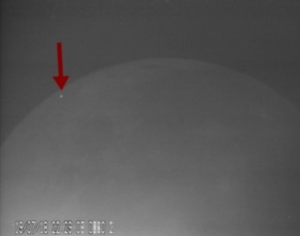 21:53, 19 July
21:53, 19 July 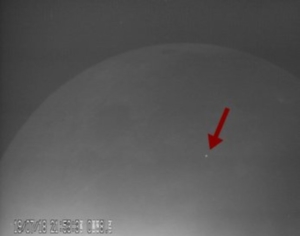 22:29, 19 July
22:29, 19 July 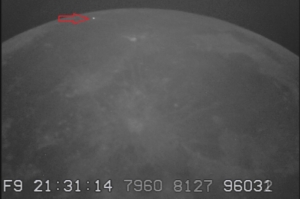 21:31 14 August
21:31 14 August
A news report about the July 17 impacts posted on the networking website LinkedIN (and also posted on space.com) stated that the meteor impacts that hit the moon on July 17 were estimated to be about the size of walnuts and determined to be members of a minor meteor stream alpha Capricornids. This minor stream is derived from the comet 169P/NEAT. Confirming observations for the above flashes are requested; also if anyone has observed a flash that needs verification, please let us know.
We have at least a fair shot at capturing lunar Perseids this month. The moon is New just before the maximum but the waning crescent Moon leading up to New, as well as, and especially the waxing crescent Moon after the 13th are favorably placed for observation of lunar Perseids. The section will continue the ongoing work of coordinating observations for this and other meteor showers throughout the remainder of 2018 and beyond. Check the ALPO website and/or join the Lunarimpacts listserve for more information.
Reports of Lunar Meteors
Lunar Geminid Watch December 2017
| The home page of ALPO currently features some observations that were made during the Geminid meteor activity last December. Visit http://alpo-astronomy.org/index.htm where it describes with an image (also shown at right, courtesy of , the observations made, collaborations performed, and impact recorded on 14 December 2017. This is a preview of the next JALPO issue due out at any time now. An organization featured in this is the NELIOTA group; more information about them, including the 30 or so impact observations made during the last two years can be viewed at their website at https://neliota.astro.noa.gr/
The image at the right was taken from a video made by Marcelo Zurita, observing from Araruna, PB, Brazil. He used a 130mm f/5 Newtonian + SCB 2000 Camera. This impact event happened at 07:13:46UT on 14 Dec. 2017 and was confirmed by Romualdo Caldas with an 8-inch Schmidt and ASI 1600 Mono Cooled Camera. |
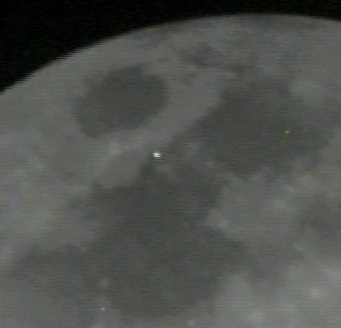 |
Sporadic Meteor Impact Candidate
I have received the following report from Dr. Anthony Cook, Department of Physics, Aberystwyth University, United Kingdom: “After going through some video footage I obtained back in January
for my MPhys 4th year project student, I think we may have a possible impact flash. This was recorded on 2017Jan17 UT 17:47:18 +/- a few sec. It was in the vicinity of Wolf crater. Duration about
two 1/25 sec TV frames taken on a Watec 902H. I enclose a RGB image where red is the before frame, green is the first detection, and blue is the next frame. Haven’t had a chance to de-interlace yet and pull out 1/50th sec de-interlaced fields yet.”
The image is shown below with the candidate indicated. This may have been recorded by any group in Europe, so a confirming observation is requested. It is likely a sporadic, since no major showers were active at the time of the observation.
Possible Lunar Quadrantid Meteors
During the annual Quadrantid meteor shower early in January, the Italian-Swiss group made two detections
Candidate #1: 20170101 at 17:47:15 UT, lasted 2 integration fields (40 ms), imaged with one telescope.
Candidate #2: 20170103 at 19:18:41 UT, lasted 4 integration fields (80 ms), imaged with two telescopes.
Runs were performed from Rome (Italy), Gordola and Locarno (Switzerland). The team consists of Lena Raffaello, Iten Marco, and Sposetti Stefano
The images were obtained on 1 January 2017 at 17:47:15UT and 3 January 2017 at 19:18:41
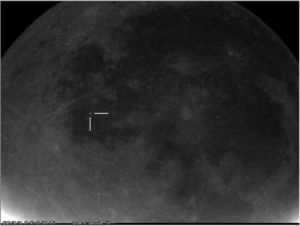 |
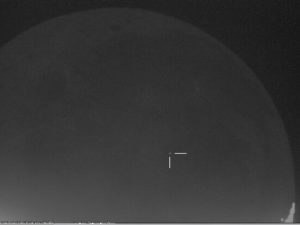 |
March Sporadic Meteor
Antonio Mercatali of the Unione Astrofili Italiani (UAI) group (www.uai.it) reports an observation of a suspected meteor impact flash on the lunar surface (images provided below). These appear to be a genuine meteoroid impact flash but as of this writing no known confirming observation has been submitted. The flash occurred on 12 March 2016 at 18:33:02 UT; video frame rate at 25 fps with time interval of 0.04 seconds between consecutive frames.
Possible North Taurid Meteoroid Impact
The Swiss-Italian lunar meteor monitoring group, consisting of observers Rafaello Lena, Stefano Sposetti and Marco Iten, reports the observations of several impact flashes, each of which was confirmed by Dr. J.M. Madiedo’s team. These events are summarized in the below table and were observed in Europe when the Moon was below the horizon for North America. However anyone monitoring the moon from North America with video and at least an 8-inch telescope had a good chance of observing impacts from the Northern Taurid meteor stream. The North Taurids are noted as being the very likely source of the impact that was the first of over 300 events to be observed by the Meteoroid Environment team at NASA-Marshall Space Flight Center ten years ago.
The four flash detected by Stefano have following selenographic coordinates from Dr. Lena’s preliminary computation using LTVT software package (Mosher and Bondo).
Impact flash: 7 November 2015 03:31:26 UT — longitude 50.9° E +/- 0.4 ° latitude 24.0° N +/- 0.4 °=> north edge of Mare Crisium about 104 km west of Eimmart crater (images courtesy of Stefano Sposetti)
Impact Flash: 7 November 2015 04:14:07 UT — longitude 48.8° E +/- 0.4 ° latitude 0.70° S +/- 0.3 ° => Mare Fecunditatis about 54 km north east of Messier crater
Impact Flash: 7 November 2015 05:06:45 UT — longitude 62.4° E +/- 0.4° latitude 4.90° S +/- 0.3 ° => Mare Fecunditatis about 130 km north of Langrenus crater
Impact Flash: 8 November 2015 05:14:09 UT — longitude 28.4° E +/- 0.4° latitude 7.3° S +/- 0.3 ° .=> about 83 km south of Torricelli crater
One additional flash event observed 15 November 2015 18:13:57UT has also been confirmed by J.M. Madiedo (image not presently available)
Many thanks to the Swiss-Italian team for their excellent work and for reporting these results
Information about opportunities to observe the Moon for meteor impacts in 2016 can be found on the ALPO Lunar Meteoritic Impact Search website linked in the next section.
More notes on the observations of lunar meteors
Activity in this area has been quite slow as there has not been any major meteor showers occurring when the moon is favorably placed; nor has their been any spacecraft missions to the Moon (since LADEE) needing ground-based support. Nonetheless the www.alpo-astronomy.org/lunarupload/lunimpacts.htm main website does have updated information for the campaign for the current quarter of the year (July 1 thru Sep 30).
Earlier reports and images remain archived below…
I received the following report from the Impact Observers Stefano Sposetti, Marco Iten and Raffaello Lena. They report:
Marco Iten detected an interesting luminous event most probably generated by a meteoroidal impact on the Moon occurred the 26 February 2015. The position of the flash was along the terminator. The brightness of the flash 0.16 s after the initial detection was +8.0 magV. After the main lightdrop a successive residual diffuse light lasted for several seconds. Under the assumption of a meteoroidal impact, we argue that this post luminous event and its ever-growing dimensions was likely caused by the sunlight reflection on ejected materials released by the impact. Marco Iten detected it visually using no dedicated searching software.
We placed our preliminary report here: http://digilander.libero.it/glrgroup/
or directly to the pdf file: http://www.lunar-captures.com//Selenology_Today/ST_preliminary%20report_2015.pdf
Marco Iten
Raffaello Lena
Stefano Sposetti
I, Brian Cudnik, showed the video of the event to Impact Expert H. Jay Melosh of Purdue University (USA) and he agrees that this appears to be a genuine impact event, with the ejection of dust that is made visible as it rises into sunlight. He suggested making measurements to find the height of the dust cloud. This animated gif image (aka, the “video”) is presented below; click on this image to view the animated gif sequence of the impact.
Lunar Project Overview (Involvement with the LADEE mission)
The LADEE (Lunar Atmosphere Dust Environment Explorer) mission is history:
We have received official word from the Mission Operations Manager – LADEE has impacted the Moon!
Last contact, before LADEE went behind the Moon, was at DOY-108 [April 18] 04:30 UTC. Re-establishment of contact would have occurred at DOY-108 05:22 UTC. After achieving over 140 days of science and meeting its primary mission goals, LADEE dropped into a lower orbit for the extended mission phase in order to collect high value science data at extremely low altitudes. In anticipation of impact, we have been downloading science data on each of today’s low-altitude passes to ensure that we retain as much of the collected data as possible.
The LADEE team is doing well, with a mixture of pride and melancholy (and some celebration!).
For the duration of the more than 140 days of LADEE operations Mr. Cudnik had been one of about two dozen coordinators worldwide who coordinated and collected lunar meteoroid flash observations (such as the examples shown below). The images will go a long way to support the efforts of the Lunar Atmosphere and Dust Environment Explorer team as they sift through much science data collected by LADEE (“LAH-Dee”) during its four-month mission. The aim is to correlated changes in dust concentration with impact events. The spacecraft made impact on the far side of the moon, out of view for ground-based observers. More information on this NASA mission can be obtained at http://www.nasa.gov/mission_pages/ladee/main/#.Uw4V1uNdV8E
The work of ground based video observers to monitor the moon with low light video cameras and telescopes in the 8 to 14 inch (20 to 36 cm) size range for up to two weeks per month will continue beyond the life of LADEE. These observations will not only support the science results of LADEE but will also continue to illuminate the frequency and size of lunar meteors, among other results. This web site will continue to serve to provide near-real-time images and information as they are received from observers. The mirror site, hosted on the Association of Lunar and Planetary Observers (ALPO) website will give dates of observations each month, background information, and other monthly updates as needed. The ALPO-based mirror site can be accessed via this URL: http://www.alpo-astronomy.org/lunarblog/lunimpacts.htm.
If you are interested in joining our efforts and want to make a scientifically useful contribution, please “tune in” to the archived workshop that was held December 5, 2013. The archive is about 4 hours in length but there is a lot of great information and discussion contained therein. View it here: http://connect.arc.nasa.gov/p4zpsnm6weh/ (you may need to copy and paste this link into your favorite browser)
Lunar Project Updates
I have not received any recent reports as of this writing aside from what I have provided below, it is possible given the weather we have been experiencing as of late, many observers may have been clouded out. Earlier observing cycles have featured impact candidates that are presented below, starting with the most recent events.
George Varros reported:
Brian, here are two candidates from Jan 5. I don’t know what to make of them. They are both single video field events and are dim but don’t look like cosmic rays because of their nice shape and brightness centroids. They have a similar look, are dim and very short, just like the one from Jan 4. (I’m rescanning everything using Lunarscan 1.5 after experiencing anomalies or unexpected results.)
Jan 5, 2014 00:12:26 Lat 15.321S Lon 25.489E inside crater Cyrillus F
Jan 5, 2014 00:31:35 Lat 15.5N Lon 20.6E
[Images courtesy of George Varros]
——————————————————————–
This is a detection by Marco Iten and Stefano Sposetti of a probable impact event on the moon. These are members of the Swiss-Italian team of lunar observers.
———-
Date: 2014 Jan 7
UT Time: 18:19:31.0
Air mass: 1.39
Lunar coordinates: 15.5° West, 19.5° North (Mare Imbrium)
Duration: 20 ms
Brightness: –
Presence of artificial satellites along the line-of-view: none in a 3deg diameter
Iten’s instrument: 125mm refractor with WAT902H2 Ultimate
Sposetti’s instrument: 280mm reflector with WAT902H2 Ultimate
Images courtesy of (left) M. Iten and (right) S. Sposetti.
——————————————————————–
Lunar meteor observer George Varros reports the following impact candidate:
I found a single video field event that may or may not be an impact. It occurred on Jan 4, 2014, at 23:49:37 UT, just south of Gambart B at Lat 0.979 Long -11.56 I uploaded and posted an image and a map, in a new folder labeled “01/04/2014 candidate”.
Although it’s only one video field, the event does not have the visual appearance of a cosmic ray in that it has a brighter center and is in a matrix of 3×3 pixels – it looks somewhat stellar.
It was not detected by Lunarscan probably because the event is only seen in the even video field – the odd field was blank along with the odd field of the next frame. The picture is dark because I probably have my gain set too low.
The map image in the folder was made using Registax and consists of 30 video frames surrounding the event, to help pinpoint it’s location and to boost the signal.
The image of the impact candidate is shown below (Image courtesy of George Varros):
We received several observations of likely lunar meteor impacts in December, and the images are provided below. One impact flash was observed on December 7, and another on December 8, with both observations being made by the Swiss-Italian lunar observation team. With the following images the team reports: “Saturday, Dec 7, Marco Iten, Raffello Lena, Andrea Manna and I, made some video recordings of the crescent Moon. We got good, but also poor sky conditions. 2 of us, Marco Iten and I, detected independently and simultaneously a small flash on the Moon. The image of Marco Iten [below, right] shows a very nice bright point of light, lasting about 4 fields (ie. 80 ms). My image is a lot blurred [below, left] because of wind and strong turbulence, the flash is washed out but clearly visible at the same instant and in the same lunar region. The air mass at the moment of the detection was 3.9.
No artificial satellites were along the line-of sight inside a 3deg diameter centered on the Moon coordinates. We performed no photometry of the flash. To note that Marco Iten noticed the flash visually in real time, while looking at the laptop screen.
In summary:
———-
Date: 2013 Dec 7
UT Time: 19:31:06.6
Air mass: 3.9
Lunar coordinates: 11° West, 14° South (Mare Nubium)
Duration: 80 ms
Luminosity: –
Iten’s instrument: 125mm refractor with WAT902H2 Ultimate
Sposetti’s instrument: 150mm refractor with WAT902H2 Ultimate
Analysis of the rest of the AVI-files is under way.
Best regards. For the Swiss-Italian group, Stefano Sposetti
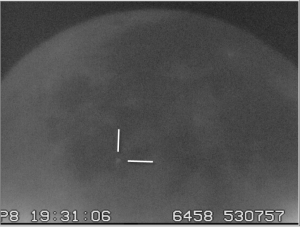 |
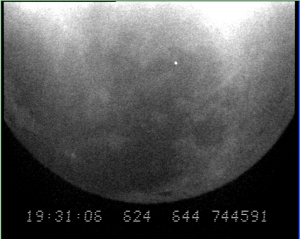 Courtesy S. Sposetti (left) and M. Iten (right) Courtesy S. Sposetti (left) and M. Iten (right) |
The same group reports another probable impact event on December 8, 2013:Marco Iten, Raffello Lena, Andrea Manna and I made some video recordings of the crescent Moon in the first half of December 2013. The December 8th, 2 of us, Marco Iten and Stefano Sposetti, detected independently and simultaneously a small flash on the Moon. The image of Marco Iten shows a somewhat bright point of light, lasting about 2 fields (ie. 40 ms). The flash of light in the Sposetti’s image is less evident.
The air mass at the moment of the detection was 2.19. The geostationary satellite INTELSAT 907 was at 66arcmin from the Moon centre at the moment of the detection, i.e. outside the field of view. No other satellites were in a 3degree diameter circle centered on the Moon coordinates. We performed no photometry of the flash.
In summary:
———-
Date: 2013 Dec 8
UT Time: 19:15:58.6
Air mass: 2.19
Lunar coordinates: 18° West, 50° South (Longomontanus crater border)
Duration: 40 ms
Luminosity: –
Iten’s instrument: 125mm refractor with WAT902H2 Ultimate
Sposetti’s instrument: 150mm refractor with WAT902H2 Ultimate
Best regards. For the Swiss-Italian group, Stefano Sposetti
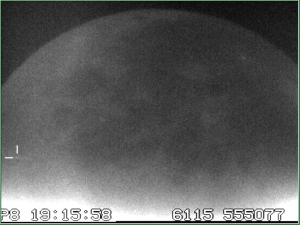 |
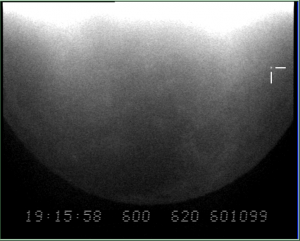 Courtesy S. Sposetti (left) and M. Iten (right) Courtesy S. Sposetti (left) and M. Iten (right) |

